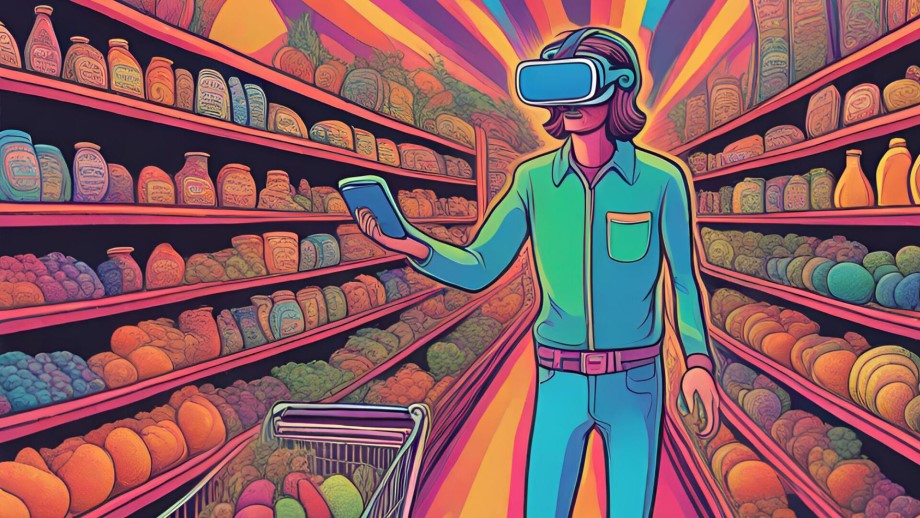
The Role of Technology in Enhancing In-Store Experiences
Technology is playing a transformative role in the future of brick-and-mortar stores. Innovations like augmented reality (AR) and virtual reality (VR) allow you to visualize products in unique ways. For example, you can try on clothes virtually or see how furniture fits in your space. These immersive experiences make shopping more engaging and help you make informed decisions.
AI-driven tools are also reshaping the in-store experience by offering personalized recommendations. Smart mirrors and interactive displays use data to suggest products based on your preferences. Additionally, AI helps stores manage inventory more efficiently, ensuring that popular items are always available when you need them.
These technologies enhance customer satisfaction while creating a more interactive and enjoyable shopping environment. By integrating AR, VR, and AI, retailers are preparing for the future of brick-and-mortar stores, where digital and physical experiences blend seamlessly. As consumer expectations evolve, adopting these tools will be key to staying competitive in the retail landscape.
Omnichannel Strategies: Blending Online and Offline Shopping
Omnichannel strategies are essential in the future of brick-and-mortar stores as they blend online and offline shopping. By integrating these experiences, you create a seamless customer journey. For example, customers can browse products online and pick them up in-store or return items bought online at physical locations. This flexibility makes the shopping process more convenient for customers.
With omnichannel strategies, you also gain access to personalized services that merge the best of both worlds. In-store associates might use customer data from online interactions to provide tailored recommendations, improving the overall experience. Additionally, features like mobile apps and self-checkout kiosks enhance the ease of shopping in physical stores while maintaining digital engagement.
The key to successful omnichannel integration is ensuring that both online and offline experiences feel connected. As retailers adopt these strategies, the future of brick-and-mortar stores will focus on creating a cohesive shopping environment where customers can switch between digital and physical experiences effortlessly. This approach will help stores remain competitive and customer-focused in an evolving retail landscape.
Sustainability and Ethical Practices in Retail
Sustainability and ethical practices are becoming a major focus in the future of brick-and-mortar stores as retailers adapt to meet the demands of conscious consumers. By adopting eco-friendly initiatives such as reducing waste, using sustainable materials, and minimizing energy consumption, you create a more environmentally responsible shopping experience. These changes not only attract eco-conscious customers but also improve brand reputation in the market.
Social responsibility is another critical factor driving this shift. Many stores are now partnering with fair-trade suppliers and supporting local communities to ensure that their products are sourced ethically. By promoting fair labor practices and giving back to their communities, retailers align their operations with values that resonate with today’s consumers.
As sustainability becomes more integrated into retail, the future of brick-and-mortar stores will depend on balancing profitability with ethical practices. You can engage customers by offering eco-friendly products and showcasing transparency in sourcing and production. These efforts build trust and loyalty, essential for thriving in a more socially aware marketplace.
The Rise of Experiential Retail
The rise of experiential retail is transforming the future of brick-and-mortar stores by shifting the focus from products to immersive, personalized experiences. Instead of merely displaying goods, stores are now creating environments where customers can engage with brands in unique ways. This approach encourages shoppers to spend more time in-store, building stronger connections with products and services.
Retailers are incorporating interactive elements such as workshops, product demonstrations, and virtual reality experiences to enhance customer engagement. These personalized experiences help differentiate your store from online competitors and foster loyalty by offering something that e-commerce cannot replicate. You are not just selling products but providing memorable, customer-centric experiences.
The future of brick-and-mortar stores lies in blending the physical and emotional aspects of shopping. By focusing on creating immersive, tailored experiences, you can make the in-store visit a destination in itself. This strategy not only drives foot traffic but also encourages repeat visits, ensuring that your store remains relevant in a rapidly evolving retail landscape.
Adapting to Consumer Behavior Changes Post-Pandemic
The future of brick-and-mortar stores is being shaped by shifts in consumer behavior following the COVID-19 pandemic. Physical stores have had to adapt to new health-conscious preferences, emphasizing cleanliness, contactless payments, and curbside pickups. You are likely seeing more retailers implementing these features to provide a safer, more convenient shopping experience that caters to post-pandemic concerns.
In addition to health considerations, consumers now expect greater flexibility between online and in-store shopping. Stores are evolving into hybrid spaces where digital tools, like mobile apps and QR codes, enhance the in-store experience. This shift allows you to meet customer demand for quick, seamless, and efficient interactions that blend physical and digital shopping.
Finally, the future of brick-and-mortar stores involves focusing on local and community-driven initiatives. Post-pandemic, many consumers prefer supporting nearby businesses, making it essential for stores to adapt by fostering personal connections and offering unique, localized experiences. These changes ensure that your store remains competitive while aligning with evolving consumer needs.
The Role of Brick-and-Mortar in Last-Mile Fulfillment
The future of brick-and-mortar stores is evolving as they play a larger role in last-mile fulfillment. Many physical locations are being transformed into local fulfillment centers, allowing for faster delivery and more convenient pickup options. This shift means you can now order products online and pick them up at a nearby store, reducing delivery times and offering greater flexibility.
Brick-and-mortar stores are also helping retailers meet the growing demand for same-day and next-day delivery. By using these stores as local hubs, businesses can fulfill orders more quickly, reducing the logistical burden on central warehouses. As a result, this strategy not only enhances customer satisfaction but also lowers shipping costs, making it a win-win for both customers and businesses.
As brick-and-mortar stores embrace their role in last-mile fulfillment, they provide a key advantage in offering faster and more efficient services. This transformation highlights the importance of physical locations in retail’s future, ensuring that they remain relevant and valuable in an increasingly digital shopping world. The future of brick-and-mortar stores is about more than just shopping in person—it’s about blending convenience, speed, and local accessibility to meet modern consumer expectations.
Conclusion
The future of brick-and-mortar stores will be shaped by how well they adapt to changing consumer behaviors and technology. As stores become more focused on creating immersive experiences and fulfilling online orders locally, they will maintain their relevance in an increasingly digital world. You will likely see a continued blending of physical and online shopping, offering convenience and speed.
For brick-and-mortar stores, sustainability and customer experience will be key factors in staying competitive. By evolving alongside consumer demands and technological advancements, they can remain valuable to customers. The future of brick-and-mortar stores depends on this ability to innovate and integrate seamlessly with the digital age.


